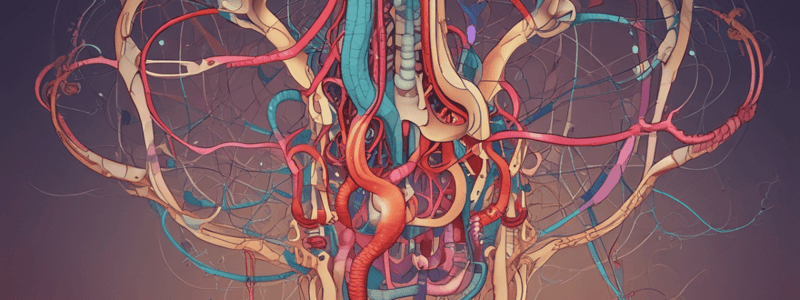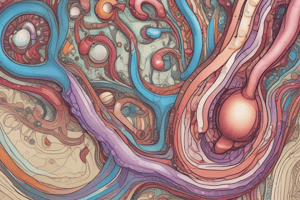Podcast
Questions and Answers
What is the structure that receives the afferent arteriole?
What is the structure that receives the afferent arteriole?
- Proximal convoluted tubule
- Glomerulus (correct)
- Efferent arteriole
- Bowman's capsule
What is the function of the glomerulus?
What is the function of the glomerulus?
- To reabsorb water from the filtrate
- To secrete hormones that regulate blood pressure
- To store urine until it is excreted
- To filter out waste and excess ions from the blood (correct)
What is the name of the vessel that carries blood away from the glomerulus?
What is the name of the vessel that carries blood away from the glomerulus?
- Proximal convoluted tubule
- Afferent arteriole
- Renal artery
- Efferent arteriole (correct)
What is the name of the structure that collects the filtrate from the glomerulus?
What is the name of the structure that collects the filtrate from the glomerulus?
What is unique about the kidneys of desert rats?
What is unique about the kidneys of desert rats?
What is the name of the next part of the nephron after the glomerulus?
What is the name of the next part of the nephron after the glomerulus?
Why is the proximal convoluted tubule given its name?
Why is the proximal convoluted tubule given its name?
What is the function of the nephron?
What is the function of the nephron?
What is the primary function of the efferent arteriole?
What is the primary function of the efferent arteriole?
What is the primary function of the proximal convoluted tubule?
What is the primary function of the proximal convoluted tubule?
What is the name given to the capillaries that surround the tubules?
What is the name given to the capillaries that surround the tubules?
What happens to the oxygen in the blood as it passes through the peritubular capillaries?
What happens to the oxygen in the blood as it passes through the peritubular capillaries?
What percentage of ions and nutrients is reabsorbed in the proximal convoluted tubule?
What percentage of ions and nutrients is reabsorbed in the proximal convoluted tubule?
What is the final destination of the urine formed in the collecting tubule?
What is the final destination of the urine formed in the collecting tubule?
What is the name of the structure that follows the proximal convoluted tubule?
What is the name of the structure that follows the proximal convoluted tubule?
What is the purpose of the peritubular capillaries in the nephron?
What is the purpose of the peritubular capillaries in the nephron?
What is the main function of the descending limb of the Loop of Henle?
What is the main function of the descending limb of the Loop of Henle?
What is the name of the blood vessel that takes the reabsorbed nutrients back to the rest of the body?
What is the name of the blood vessel that takes the reabsorbed nutrients back to the rest of the body?
What is the main function of the ascending limb of the Loop of Henle?
What is the main function of the ascending limb of the Loop of Henle?
What is the term for the process that occurs in the Loop of Henle?
What is the term for the process that occurs in the Loop of Henle?
What drives the passive reabsorption of water in the descending limb of the Loop of Henle?
What drives the passive reabsorption of water in the descending limb of the Loop of Henle?
What is the main function of the distal convoluted tubule?
What is the main function of the distal convoluted tubule?
What is the term for the space around the tubule or nephron?
What is the term for the space around the tubule or nephron?
Where does the reabsorption of ions occur in the Loop of Henle?
Where does the reabsorption of ions occur in the Loop of Henle?
What is the name of the structure formed by the distal convoluted tubule and the glomerulus?
What is the name of the structure formed by the distal convoluted tubule and the glomerulus?
What is the result of countercurrent multiplication in the Loop of Henle?
What is the result of countercurrent multiplication in the Loop of Henle?
What is the primary function of the collecting tubule or collecting duct?
What is the primary function of the collecting tubule or collecting duct?
What is reabsorbed in the collecting tubule to maintain osmolarity in the medulla?
What is reabsorbed in the collecting tubule to maintain osmolarity in the medulla?
What is the term for the process of reabsorbing urea to increase osmolarity in the medulla?
What is the term for the process of reabsorbing urea to increase osmolarity in the medulla?
What is the relationship between the distal convoluted tubule and the collecting duct?
What is the relationship between the distal convoluted tubule and the collecting duct?
What happens to the efferent arteriole after it reabsorbs all the necessary substances?
What happens to the efferent arteriole after it reabsorbs all the necessary substances?
What is the main difference between the proximal convoluted tubule and the distal convoluted tubule?
What is the main difference between the proximal convoluted tubule and the distal convoluted tubule?
Flashcards are hidden until you start studying
Study Notes
Structure and Function of Nephrons
- The nephron is the functional unit of the kidney, consisting of the glomerulus, Bowman's capsule, proximal convoluted tubule, loop of Henle, distal convoluted tubule, and collecting duct.
Glomerulus and Bowman's Capsule
- The glomerulus receives an afferent arteriole, and its function is to filter out a ton of fluid from the blood into Bowman's capsule.
- Bowman's capsule is the first part of the nephron to collect fluid that will be filtered to become urine.
Proximal Convoluted Tubule
- The proximal convoluted tubule is the next part of the nephron, located close to the glomerulus, and is responsible for reabsorbing ions, amino acids, glucose, and water.
- It reabsorbs about 65% of all important nutrients, the most of anywhere else in the nephron.
Loop of Henle
- The loop of Henle is a U-shaped structure that descends deep into the kidney and then ascends back up again.
- It consists of two limbs: the descending limb, which reabsorbs water, and the ascending limb, which reabsorbs ions like sodium, chloride, and potassium.
- The loop of Henle is involved in countercurrent multiplication, a process that allows the kidney to reabsorb large amounts of water and ions.
Distal Convoluted Tubule
- The distal convoluted tubule is responsible for the reabsorption of other ions, like sodium and chloride, and helps to pick up more important nutrients that we don't want to excrete.
- It forms a "kiss" with the glomerulus, which is part of the juxtaglomerular apparatus, involved in controlling blood pressure.
Collecting Duct and Urea Recycling
- The collecting duct, or collecting tubule, collects leftover fluid from the distal convoluted tubule and reabsorbs water and urea.
- Urea is reabsorbed to maintain osmolarity in the medulla, which helps drive water reabsorption in the loop of Henle.
Peritubular Capillaries and Renal Vein
- The efferent arteriole gives rise to peritubular capillaries, which collect reabsorbed nutrients and transport them back into the bloodstream.
- The peritubular capillaries eventually merge to form the renal vein, which carries the reabsorbed nutrients back to the rest of the body.
- The remaining fluid in the collecting duct becomes urine, which flows into the renal calyces and is excreted.
Studying That Suits You
Use AI to generate personalized quizzes and flashcards to suit your learning preferences.



